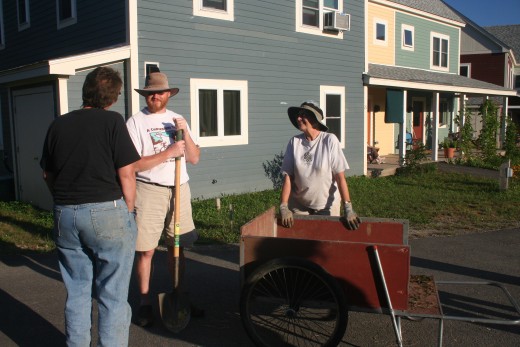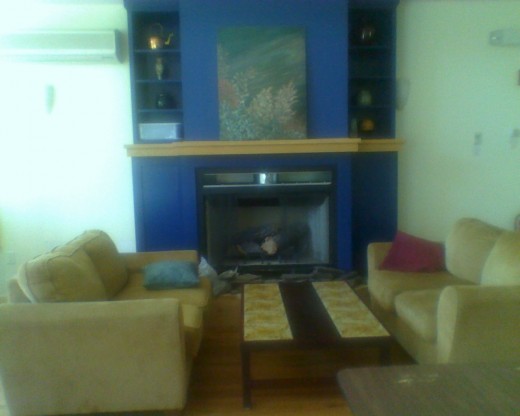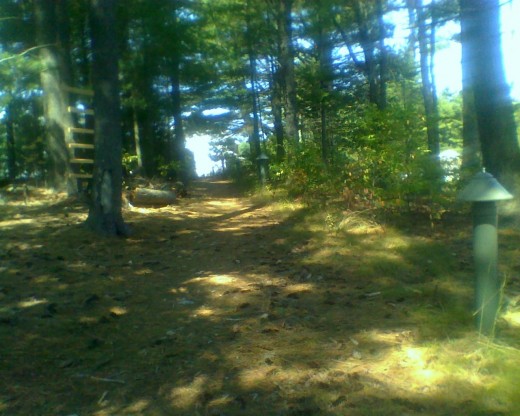10 Great Things About Cohousing
10 Aspects of Living in Community that Make it Rock
Introduction
Living in an Intentional Community such as that offered by a Co-housing Village can benefit everybody, both within the individual community and those living in the greater town or city community in which the co-housing village is nestled. The town or city benefits from the extra tax income and social involvement of the the members of the comparatively smaller co-housing community or Ecovillage. The co-housing community benefits from the close proximity of resources. My own community Mosaic Commons, is located within the larger Sawyer Hill Ecovillage, along with the co-housing community North of us, Camelot Co-housing. We all pay taxes to the town we are located in, have children that attend the local public schools, participate in local sports and other social activities, and have members who hold positions of service, such as Librarians, Lions Club members and a member of the Town Finance Committee. We have also reached out to the town by hosting programs of mutual interest, such as a presentation of an historian about the local town history, seasonal gatherings, house concerts, and invitations to our community dinners. We benefit from having the post office and a couple of local farms within walking or biking distance. Since co-housing is a new lifestyle in the United States, little is known about it by people who are not involved directly in creating and living in such communities. General awareness is growing, but the best PR is reaching out actively to offer bonds of mutual benefit between the co-housing village and the town it is situated in. The purpose of this hub is to outline 10 ways in which co-housing benefits the members directly. These benefits cannot help but benefit the larger community surrounding the co-housing community or ecovillage, and this will be described as it applies to each benefit listed below.
Images of Cohousing in Action







1. Friendly neighbors who want to get to know you
There is nothing that speaks more to feeling like you have moved to a friendly, genuinely welcoming neighborhood as when there are friendly people who wave and talk to you when you step out your front door. People in cohousing are interested in each other, care about one another's well-being, and want to help out if there is anything they can do when the need for such help arises. If they spot you on your way in the door from your work day or a long trip, they wave you over to find out about how your day or week went.
2. Decision Making by Consensus
Making a decision by consensus means that no decision is made unless everyone can live with it. This takes patience, thoughtfulness, creativity, and compromise - qualities not required by "majority rule." The entire community looks for a "win-win" situation for all community members, instead of one group "winning" and another group "losing." There is a level of trust that develops when everyone seeks the happiness and comfort of the community as a whole, and is willing to take into consideration the comfort of all its members. The community meets each month to discuss issues, and there are "process cards" that are used, which encourages each member to listen carefully and wait for their turn to speak.
3. Exchange of favors and resources is good for everyone's budget
In cohousing, neighbors tend to exchange favors and personal resources, such as moving in each others' belongings, watching pets, watering gardens, putting together furniture, painting rooms, sharing tools, watching children, etc. This saves on expenses such as child care, kennels, or unnecessarily buying new tools one would use only occasionally. There is a community gardening "shed" in one of the unsold carports, clotheslines for community use, washers/dryers, a fitness room, a wooded labyrinth, basketball hoops, playground equipment, and a playing field among other resources. In the community carport are also community-owned lawn mowers, and other equipment for which we set aside funds in our community budget. We often offer and acquire things through the online Freecycle network.
4. Sharing community over meals at least twice a week
One of the hallmarks of forming community and keeping the spirit alive for a group of people is the opportunity to eat together often. There is a group of people who rotate cooking, serving as assistant cook (including setup of the Great Room), and cleanup. The bond among community members is strengthened by sharing meals together, so our community eats a common dinner together two weekday nights a week, and brunch one weekend morning. Not only do we welcome our own community members to the table, we welcome the friends and family of our fellow community members, for we are a friendly bunch of humans and are eager to expand our ever-widening circle of "family."
5. Contributions made according to individual talents and passions
The common resources owned and benefited from by a community exist because of the combined contributions of all community members. Some people are technology-savvy, some are awesome cooks, and others are passionate gardeners. There are teams of people who keep our grounds and machinery in working order, and our common spaces clean and tidy for the frequent use they are given. Everyone contributes according to their talents and abilities, and thus our interdependence is reinforced. The bond between community members is also strengthened by working together.
6. Carpooling and other opportunities benefit the environment
Carpooling is a big asset to living in a cohousing community. It is doubled when one lives in an "ecovillage" that encompasses two cohousing communities. The odds are increased that there is a group of people sharing the responsibility of driving to a town nearby where you work, or to a local train station on a line that stops close to your place of work. Many people here also include each other in more local errands and visits to cultural sites. There is an email list for communicating with everyone else, so someone can post a message about an errand they are about to embark upon so that others may take advantage of it. People will pick up items needed by others if they are going to a particular store, or invite them to come along for the ride. There is a local pond and a rock formation for climbing that our community members have carpooled to, as well.
7. Community and Individual Gardens
One of the factors that benefits our community is the land we live on. It used to belong to a local farm, and then a nursery. There are many acres that are spread out, and one spot was chosen for our community vegetable garden. There is a community herb garden by the Common House entrance closest to the kitchen. These food items usually grow in enough abundance for the entire community to share in, but the priority is given to cooks preparing common meals. Community members passionate about gardening have chosen the plot of these gardens and planted the items we enjoy eating, fresh from their source. Others have taken turns watering all of the community gardens. By the vegetable garden there are compost piles for enriching the soil in which we grow our food, organically. They include dry leaves and grass clippings as mulch. This summer, we have enjoyed the benefits of all these efforts and they have been very satisfying...and downright delicious!
8. Big porches that encourage spontaneous gatherings
The buildings designed and constructed for cohousing villages vary from one community to another. Those who founded Mosaic Commons chose to make big porches a priority, and they have been used well. There have been organized gatherings on porches for birthdays, cocktails, card games, and crafts. Other gatherings have been spontaneous. Comfortable furniture is kept on each porch, and community members visit with one another often, especially during the warmer months. When there are larger gatherings, such as barbeques, the Common House porch is well-populated, as well as the long picnic table across from the Common House. The bonding between community members takes place during these gatherings as much as it does during common meals and community work.
Warning: Porch "strolling" can be habit-forming! On any given Saturday night, while the summer is in full force and I have time to fritter away before I drive to the train station to meet my husband for his ride home, I eat dinner on one neighbor's porch and visit with her, then stop by another neighbor's porch for a drop of wine and more fun conversation, before I make my way back to my own home to wait for my daughter to return from her own gallivanting with neighbors and their children. Aaaaah...that's the spirit of co-housing!
9. Lots of eyes to watch over children
Children are cared for, watched over, and kept safe in a cohousing community. Each adult will step in if they see one child treating another inappropriately, or give a child a bandaid if he or she is hurt. There is a system in our community, as well as others', that involves parents having other parents' landline and cell phone numbers to alert them as to the location of their child(ren). When children play, they often travel from house to house, and sometimes forget to check in as often as their parents would like. Because of this, if a child suddenly appears at a home they were not previously playing at, the adult present in that home will call to alert the parent of the wandering urchin.
In addition to the above safety net, all adults in the community are vigilant about whether there is a "stranger" on our property. We reach out with a friendly handshake to anyone we do not recognize to ask if they would like a tour, or are there to visit a particular community member. They do not remain a "stranger" for long, and our children are kept safe from any potential harm. There is no way for an individual to remain "anonymous" in our community.
10. Close proximity to town encourages transportation by walking and biking
My cohousing community is located in a rural town, which is very hilly. We use cars to get around often, but we cycle to town when we can. There are two farms, the town post office, a library, and several churches that are in cycling distance. There is conservation land and a wooded labyrinth on our grounds to walk around for exercise, fresh air, and the enjoyment of local flora and fauna. Within the village, both children and adults travel from one end of the property to the other, or to the common house, by scooter.
Cohousing communities promote sustainable living, and a healthy lifestyle. The beauty of gardens, chimes, and local wildlife surrounds us. We work together, rally to help solve problems with one another, and lift each other up. Our children play together, and in the long run they grow up together. Money, time, and energy is saved through the lifestyle promoted by cohousing, and loneliness is not a problem known to anyone in such a community.
Elders in Co-housing
There are many benefits for all neighbors of all ages who live in a co-housing community. There are several people over 65 years old who live in our community and contribute an abundance of wisdom and skill in leading the community toward greater understanding of and cooperation with each other. The very young have extra eyes watching out for them as they migrate with their games. Their young energy keeps the older community members in good spirits.
Benefits of Co-housing for Elders
Many elders have begun to reach out to each other in friendship and community. My mother has a bunch or friends in her gated community in Virginia with whom she shares meals, interests, travel, and car rides to doctor appointments. But a co-housing community is not a gated community. It is a place where the other citizens of the town in which the community is located are welcome to visit and there is a mutual exchange of benefits. Below are three mportant ways co-housing as a style of intentional community benefits elder citizens.
1. Surrounded by caring neighbors ~ Those who live as members of an intentional community are not isolated. They are surrounded by neighbors who care and would help in any way they needed. The walking paths in our community are kept well-lit and smoothly paved so that they stay safe as they move around our village.
2. Their knowledge and gifts are valued ~ Co-housing communities thrive best when the talents of all individuals are shared for the good of everyone. Elders are respected for their wisdom and experience, and their gifts are gratefully received by the other members of the community. While my grandmother was still alive, she still enjoyed great vigor and gave of her energy by helping to maintain the landscaping throughout her elder community. The elders in my co-housing community help drive projects and maintain communication with contractors that work for us on a continual basis. They work in our community gardens and help clean up after meals.
3. Meals shared enhance vitality ~ Sharing meals together decreases loneliness and increases confidence in an elder's ability to live independently. There is a sense of shared experience, and acceptance of individual personality quirks. That acceptance and respect helps elders maintain their will to keep thriving.
Conclusion
Co-housing communities are a return to the values that promote the growth and mutual respect of community members throughout their life span. Those who choose to live in such communities are committed to being good and generous neighbors. It takes work to keep the communication flowing and member households of all ages cooperative and willing to contribute time and energy to maintaining community spaces, in addition to private residences. We eat together, talk together, work together, grow together, and even sing together. Our overall quality of life is enhanced by our home environment. We love where we live.
Co-housing Communities across the United States
Sawyer Hill Ecovillage includes Mosaic Commons and Camelot Cohousing.
Located in a charming corner of Boston, this co-housing community is accessible to public transportation, walking paths, and bike paths.
One of two co-housing communities in Amherst, MA
This unit is for sale in this co-housing village.
A co-housing community presently under construction in California.
A co-housing Community in Portland, OR
A co-housing community in the Southwest region of the US
Find your local co-housing headquarters
For many states there are local co-housing directories that give more specific information about where to find the local co-housing communities in that state. Massachusetts has one, as does Colorado, California, Virginia, and other states across the country. There is also a national co-housing organization with their own web site.
* Focusing your search for a visit will lead you to the web sites for these individual communities, the contact information for individuals willing to give you a tour, and possibly answers to other questions you may have. Happy hunting. May you find a cozy neighborhood of your own to come home to.
Links to Co-housing Community Sites
- The Cohousing Association of the United States
A National Co-housing site that describes what co-housing is and links to communities across the country. - Intentional Communities - ecovillages, communes, cohousing, coops
Information on Intentional Communities including ecovillages, communes, and cohousing. Communities Directory, Communities Magazine, classified ads, event claendar, wiki, blogs, video and more. - Do you know your neighbors? | Mosaic Commons
Link to the Mosaic Commons community site, which includes events that happen throughout the week. - Welcome | Sawyer Hill EcoVillage
The site that describes both Mosaic Commons and Camelot Co-housing Communities in central Massachusetts. - New View Cohousing
Another co-housing community not far from our own, with its own flavor and culture. Each co-housing community has a unique character. If you'd like to connect with a community near you, visit the Co-housing Association of the U.S. site.
Are you ready for co-housing?
Are you a member of an intentional community?
© 2010 Karen A Szklany



